 Michael Archer. Palaeontology, Geobiology and Earth Archives Research Centre (PANGEA), School of Biological, Earth and Environmental Sciences, University of New South Wales, Sydney 2052, Australia; m.archer@unsw.edu.au
Michael Archer. Palaeontology, Geobiology and Earth Archives Research Centre (PANGEA), School of Biological, Earth and Environmental Sciences, University of New South Wales, Sydney 2052, Australia; m.archer@unsw.edu.au
BA (Princeton Univ.), PhD (University of Western Australia), AM, FAA, DistFRSN, FRZS, FACE, FWAAS. Previously Curator of Mammals at the Queensland Museum, Director of the Australian Museum in Sydney, Dean of Science at the University of New South Wales. Research includes: World Heritage mid Cenozoic fossil deposits of Riversleigh, Queensland; Eocene Tingamarra deposit, Queensland; Miocene deposits in New Zealand; paleoconservation initiatives to save endangered living marsupials; deExtinction research to revive the extinct Gastric-brooding Frog. Over 320 scientific publications including 15 books and supervision of over 90 PhD/Hons research students. Additional background: http://www.pangea.unsw.edu.au/people/academic-research/michael-archer

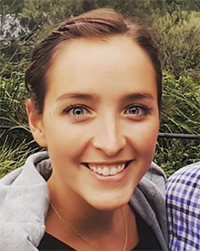 Pippa Binfield. Palaeontology, Geobiology and Earth Archives Research Centre (PANGEA), School of Biological, Earth and Environmental Sciences, University of New South Wales, Sydney 2052, Australia; pippa.binfield@outlook.com
Pippa Binfield. Palaeontology, Geobiology and Earth Archives Research Centre (PANGEA), School of Biological, Earth and Environmental Sciences, University of New South Wales, Sydney 2052, Australia; pippa.binfield@outlook.com
Pippa Binfield is a BSc Hons graduate from the School of Biological, Earth and Environmental Sciences, at the University of New South Wales. pippa.binfield@outlook.com.
Pippa completed undergraduate palaeontological research on Australian mammals from Riversleigh and central Australia, and described the Miocene marsupial species Barinya kutjamarpensis. She is currently a science reporter for the Australian Broadcasting Commission in the Asia Pacific Region.

 Suzanne J. Hand. Palaeontology, Geobiology and Earth Archives Research Centre (PANGEA), School of Biological, Earth and Environmental Sciences, University of New South Wales, Sydney 2052, Australia; s.hand@unsw.edu.au
Suzanne J. Hand. Palaeontology, Geobiology and Earth Archives Research Centre (PANGEA), School of Biological, Earth and Environmental Sciences, University of New South Wales, Sydney 2052, Australia; s.hand@unsw.edu.au
BSc Hons (University of New South Wales); PhD (Macquarie University); FRZS; FRSN. Suzanne is a vertebrate palaeontologist at the University of New South Wales where she teaches zoology and geology. Her research interests are largely in the areas of evolutionary biology, functional morphology, phylogenetics, and biogeography, with a special interest in fossil and modern mammals, particularly bats. She co-leads research of the World Heritage-listed Riversleigh fossil deposits of northern Australia and the Eocene Tingamarra fossil deposits of Queensland.

 Karen H. Black. Palaeontology, Geobiology and Earth Archives Research Centre (PANGEA), School of Biological, Earth and Environmental Sciences, University of New South Wales, Sydney 2052, Australia; k.black@unsw.edu.au
Karen H. Black. Palaeontology, Geobiology and Earth Archives Research Centre (PANGEA), School of Biological, Earth and Environmental Sciences, University of New South Wales, Sydney 2052, Australia; k.black@unsw.edu.au
PhD (University of New South Wales). She has developed a research profile in marsupial evolution, taxonomy, morphology, phylogeny, ontogeny and biocorrelation, and has named many new fossil species. Her work focuses on understanding faunal change and community structure in Australian ecosystems to provide new understanding about current and future climate-driven changes in biodiversity. Karen has 12 years experience in extracting, curating and analysing the rich fossil vertebrate faunas of the limestone deposits of the Riversleigh World Heritage Area in northwestern Queensland. She is a recipient of the Australian Academy of Science's Dorothy Hill Prize for research in the Earth Sciences.

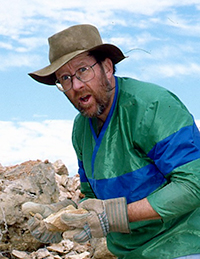 Phillip Creaser. Palaeontology, Geobiology and Earth Archives Research Centre (PANGEA), School of Biological, Earth and Environmental Sciences, University of New South Wales, Sydney 2052, Australia; philcreaser@grapevine.com.au
Phillip Creaser. Palaeontology, Geobiology and Earth Archives Research Centre (PANGEA), School of Biological, Earth and Environmental Sciences, University of New South Wales, Sydney 2052, Australia; philcreaser@grapevine.com.au
MSc Geology, Australian National University. Formerly a member of the Federal World Heritage Unit, Canberra, and Director's Assistant at the Australian Museum, Sydney. Research focuses on the geological and palaeontological resources in the Riversleigh World Heritage Area, Queensland, and the geological context of the Eocene Tingamarra deposits in Queensland. Currently co-managing a program to permanently label all of the more than 200 fossil localities in the Riversleigh area.

 Troy J. Myers. Palaeontology, Geobiology and Earth Archives Research Centre (PANGEA), School of Biological, Earth and Environmental Sciences, University of New South Wales, Sydney 2052, Australia; t.myers@unsw.edu.au
Troy J. Myers. Palaeontology, Geobiology and Earth Archives Research Centre (PANGEA), School of Biological, Earth and Environmental Sciences, University of New South Wales, Sydney 2052, Australia; t.myers@unsw.edu.au
Troy J. Myers is a Research Assistant and Senior Preparator in the PANGEA Research Centre, School of Biological, Earth and Environmental Sciences, at UNSW Sydney. t.myers@unsw.edu.au. BSc Hons & PhD (University of New South Wales). He has a research background in the systematics, morphology, palaeoecology, taphonomy and biocorrelation of Australia’s Oligo-Miocene marsupial and Cretaceous marine reptile faunas, and has more than 20 years’ experience in the extraction, preparation, curation, management and research of fossil collections, including from the Riversleigh World Heritage Area in northwestern Queensland.

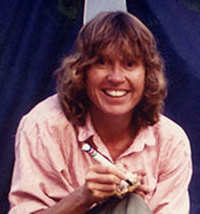 Anna K. Gillespie. Palaeontology, Geobiology and Earth Archives Research Centre (PANGEA), School of Biological, Earth and Environmental Sciences, University of New South Wales, Sydney 2052, Australia; a.gillespie@unsw.edu.au
Anna K. Gillespie. Palaeontology, Geobiology and Earth Archives Research Centre (PANGEA), School of Biological, Earth and Environmental Sciences, University of New South Wales, Sydney 2052, Australia; a.gillespie@unsw.edu.au
Anna K. Gillespie is a Research Assistant and Senior Preparator in the PANGEA Research Centre, PhD (University of New South Wales). Her doctorate focussed on marsupial lions recovered from the Riversleigh World Heritage Area of Australia. She has been one of the chief preparators of the Riversleigh WHA fossil material since 1992. Her fields of interest include the evolution of Australian vertebrates and in particular, the evolution of marsupials, marsupial lion taxonomy and systematics, and functional morphology.

 Derrick A. Arena. Palaeontology, Geobiology and Earth Archives Research Centre (PANGEA), School of Biological, Earth and Environmental Sciences, University of New South Wales, Sydney 2052, Australia; r.arena@unsw.edu.au
Derrick A. Arena. Palaeontology, Geobiology and Earth Archives Research Centre (PANGEA), School of Biological, Earth and Environmental Sciences, University of New South Wales, Sydney 2052, Australia; r.arena@unsw.edu.au
Rick Arena is an Adjunct Senior Lecturer at the PANGEA Research Centre, School of Biological, Earth and Environmental Sciences, at the University of New South Wales, Sydney, Australia. BSc Hons & PhD (University of New South Wales). He works on the geology and palaeontology, biostratigraphy of Australian Cenozoic vertebrate fossil deposits, with a focus on those of the Riversleigh World Heritage Area in northwest Queensland. His research interests include the continental biocorrelation and geocorrelation of Australia's fossil mammal deposits, cave geology, tufa deposits and taphonomy.

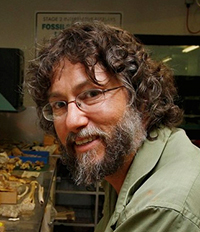 John Scanlon. Outback at Isa, Mount Isa, Queensland 4825, Australia; nanowana@gmail.com
John Scanlon. Outback at Isa, Mount Isa, Queensland 4825, Australia; nanowana@gmail.com
John Scanlon is a vertebrate biologist, affiliated with the PANGEA Research Centre, BSc Hons (University of Sydney), PhD (University of New South Wales). John specialises in the systematics, palaeontology and behavioral ecology of snakes in BSc (Hons) at the University of Sydney, PhD at the University of New South Wales, and postdoctoral research at the University of Adelaide. John was the resident palaeontologist at the Riversleigh Fossil Centre 2004-2010 and has since worked as a fauna consultant in Western Australia. Research interests include the morphological and behavioural aspects of evolution in elapid and pythonid snakes, and extinct groups such as Madtsoiidae relevant to the Mesozoic origin of snakes among squamate reptiles.

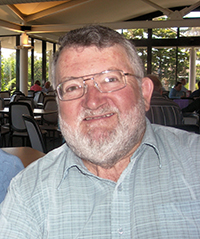 Neville Pledge. Palaeontology, South Australian Museum, North Terrace, Adelaide 5000, Australia; Neville.Pledge@samuseum.sa.gov.au
Neville Pledge. Palaeontology, South Australian Museum, North Terrace, Adelaide 5000, Australia; Neville.Pledge@samuseum.sa.gov.au
Neville Pledge is an Honorary Association of the Palaeontology Section of the South Australian Museum, Adelaide. BSc Hons (University of Adelaide), MSc (University of Wyoming). First Curator of Fossils at the South Australian Museum, Adelaide. Besides exhibition design, his initial work was on the Pleistocene vertebrate fossils of the Naracoorte Caves, South Australia. Subsequently he began a lifelong study of the Tertiary vertebrate fossils of the Lake Eyre Basin. He has published more than 50 refereed papers, as well as numerous popular articles. He has described or co-authored about 30 new species, from sharks, dinosaurs, birds, cetaceans to marsupials.

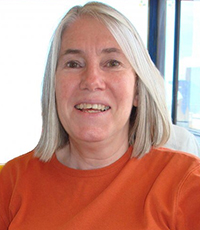 Jenni Thurmer. Palaeontology, South Australian Museum, North Terrace, Adelaide 5000, Australia; jthurmer@senet.com.au
Jenni Thurmer. Palaeontology, South Australian Museum, North Terrace, Adelaide 5000, Australia; jthurmer@senet.com.au
Jennifer Thurmer is affiliated with the Palaeontology Section of the South Australian Museum, Adelaide. Jennifer was employed by the South Australian Museum as its scientific illustrator and publication editor for twenty five years. She currently undertakes voluntary work in that museum’s fossil department and has considerable experience in the field and lab. Her current interests include the fossils of the Lake Eyre Basin, South Australia.

